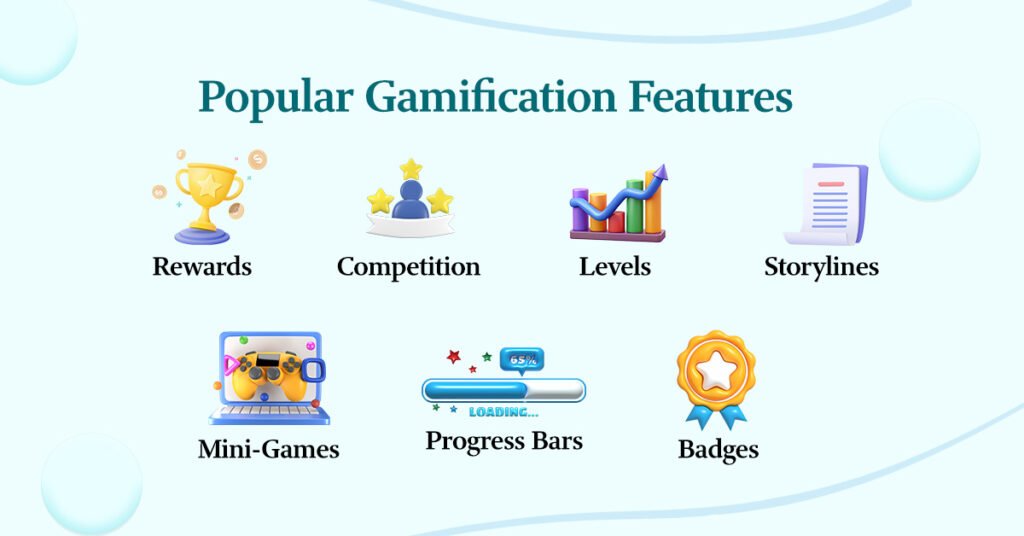Did you know?
There are nearly 2.87 million apps on the Google Play Store and around 1.96 million apps on the Apple App Store, respectively!
Sounds surprising, doesn’t it?
Though it’s never too late to start something new, it’s also pretty hard to stay ahead in today’s cutthroat app development market.
This is where the importance of in-app gamification!
Gamification, when used within mobile applications, has shown to be a game-changer in terms of increasing user engagement, retention, and customer lifetime value (LTV). Using interactive, game-like features for non-gaming applications changes the user experience, making it more engaging, rewarding, and immersive.
In addition, many studies have confirmed the effectiveness of gamification in holding users’ attention for longer periods.
Ready to explore the world of in-app gamification? Let’s dive in!
What is In-App Gamification?
In-app gamification is the integration of game mechanics into non-gaming apps in order to increase user engagement, boost retention, and enhance user experience. This is not about designing the app to be like a classic game; instead, it embeds subtle, purposeful game elements within the application interface. It’s not simply about making an app fun: it’s a UX design tactic that improves functionality while maintaining user motivation.
The best-gamified applications will blend game elements into the user experience so that they don’t feel like an addition. Education, healthcare, and corporate training are frequent adopters of gamification for better outcomes.
Why Gamify Your Mobile App?

Gamification has numerous benefits that help apps achieve both user-centric and business-centric goals.
1. Improving Customer Experience
Gamification is a creative way to deepen customer relationships. For instance, American Airlines used gamification during its merger with US Airways by launching the “Passport Challenge,” where users engaged in trivia and virtual passports, resulting in an impressive 500% ROI.
2. Retaining Users
Gamified features, such as the daily challenge and streak, prompt users to open the application multiple times. Acorns, the micro-investing application, used gamification in a way that reached 99% monthly retention. This year, it aims to double its subscribers by 2025.
3. Reducing Churn
Leaderboards, progress bars, and achievement badges are some features that will create healthy competition, thus encouraging the users to stay. Gamification taps into the psychological triggers, such as the need for recognition, and decreases churn and increases loyalty.
4. Personalized Experiences
Gamification can meet every user’s different needs and preferences. By offering customized challenges, levels, and rewards based on user behavior, an app can create a meaningfully more personalized experience for users. Research indicates that 70% of customers expect to be treated as “unique,” and this feature is essential in modern app designs.
5. Making Difficult Topics Fun
Gamification simplifies complex concepts. For example, games in financial and fitness apps, such as budgeting and tracking exercise, are made exciting through the application of gamification. Nike Run Club is a great example as it engages users through play challenges and interpersonal interaction, and they are motivated to workout.
What are the Essential Features of Gamification in Mobile Apps?

The choice of game mechanics is a necessary aspect of an app in gamification. There are seven major popular gamification features:
1. Rewards
Tangible or virtual rewards encourage users to achieve the given milestones. In-app currency or redeemable points can be used as examples.
2. Competition
Friendly challenges and leaderboards make users competitive. This creates an environment where users compete with each other to outperform.
3. Levels
Progressive levels keep the users interested in unlocking new achievements.
4. Storylines
A good story can make users emotionally invested in the app, which increases usage time.
5. Mini-Games
Short, interactive games that are embedded in the app, such as trivia or flashcard challenges, enhance the overall experience.
6. Progress Bars
Visual representations of progress, such as completion percentages or streaks, give users a sense of accomplishment.
7. Badges
Earned badges act as social proof and personal milestones, fostering a sense of community among users.
What are the Steps to Implement In-App Gamification?
Gamifying an app takes a lot of strategy and planning and requires a real understanding of the target audience. Here’s a step-by-step guide:
1. Define Clear Goals
This is a clear definition of why you are gamifying your app. Are you looking for engagement, retention, or even specific behaviors?
2. Understand Your Audience
This is where it gets fun because gamification works well when it suits the taste of your user. A younger audience, Millennials, and Gen Z, love gamification, while other older people may require something else.
3. Customize the Experience
Make the gamified elements personalized to a user’s behavior and motivation. Know whether it is rewards or competition, as it will drive your audience.

4. Simplify
Do not bombard users with too many game features. Start with some core mechanics and expand as user feedback dictates.
5. Make it Fun
The ultimate goal of making an app is to make it be enjoyable. This means that even the dullest topics, like finance, can be made exciting and accessible.
6. Share Socially
Let users share achievements on social media, so your app becomes a topic of conversation and a natural promotion tool.
How Much Does It Cost to Gamify an App?
The cost of implementing gamification in an app can vary significantly, largely depending on the complexity of the features you plan to incorporate and the tools or approaches you select. If you opt to develop custom gamification features in-house, be prepared for it to be a resource-intensive process. This approach often requires a dedicated team of developers, designers, and user experience experts working together to create tailored elements like rewards systems, leaderboards, or mini-games.
While this method allows for complete customization and alignment with your brand’s unique goals, it can also demand substantial investment in terms of time, manpower, and financial resources.
{Also Read: A Guide to Mobile App Development Cost}
What are the Major Examples of Gamification in Real Life?
1. Starbucks Rewards Program
Users get “stars” with every purchase, which they can redeem for free drinks, among other benefits, creating loyalty.
2. Mint
Mint gamifies budgeting and financial tracking, which motivates users to achieve their financial goals.
3. Nike Run Club
Gamification elements such as achievements and community challenges increase user engagement and retention.
Final Thoughts
So, there you have it! Remember that if you want to implement gamification effectively, you need to set clear goals, understand your audience, add and personalize gamification elements, and test and refine your strategy. The future of app gamification includes the integration of artificial intelligence and machine learning, augmented reality, virtual reality, and blockchain technology.
Planning to build a mobile app with in-app gamification? If so, simply visit EitBiz or you can even drop us an email at info@eitbiz.com to discuss your app development needs today!







